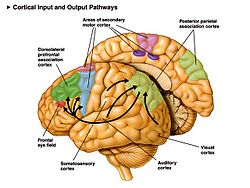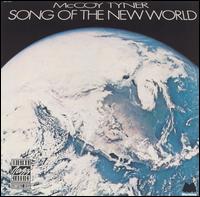보조 전동기 면적
Supplementary motor area| 보조 전동기 면적 | |
|---|---|
 인간 피질의 운동 영역이야 보조 모터 영역은 분홍색으로 표시된다. | |
 평균적인 인간의 뇌에서 보조 운동 피질의 3D 시각화 | |
| 식별자 | |
| NeuroNames | 3176 |
| FMA | 224858 |
| 신경조영술의 해부학적 용어 | |
보조 운동 영역(SMA)은 영장류 대뇌피질의 일부로서 움직임의 제어에 기여한다. 그것은 1차 운동 피질 다리 표현 바로 앞에 있는 반구의 중간선 표면에 위치해 있다. 원숭이에서 SMA는 신체의 대략적인 지도를 포함하고 있다. 인간에게 있어 신체 지도는 분명하지 않다. SMA의 뉴런은 척수에 직접 투영되며 움직임의 직접적인 제어에 역할을 할 수 있다. SMA에 귀속될 수 있는 기능으로는 신체의 자세 안정화, 양방향 작용과 같은 신체의 양쪽의 조정, 감각 사건에 의해 촉발되기보다는 내부에서 생성되는 움직임의 제어, 움직임의 순서 제어 등이 있다. 이러한 제안된 함수는 모두 가설로 남아 있다. SMA의 정확한 역할이나 역할은 아직 알려지지 않았다.
SMA의 발견과 다른 모터 피질 영역과의 관계는 모터 피질에 대한 주요 기사를 참조하십시오.
하위 영역
이제 SMA로 정의되면 더 큰 영역 내에서 최소 6개 영역이 인정된다. 이러한 세분화는 원숭이 뇌에서 가장 광범위하게 연구되어 왔다. 가장 앞쪽 부분은 현재 일반적으로 프리 SMA라고 불리고 있으며,[1][2][3] 척수나 1차 운동 피질과의 연결이 희박하거나 아예 없으며, 전방 부위와의 연결이 광범위하다.[1][4][5][6][7]
보조 눈장(SEF)은 SMA의 비교적 앞부분으로, 자극되면 머리와 눈의 움직임과 팔다리와 몸통의 움직임을 유발한다.[8][9][10][11]
Dum과 Strick은[5] 반구의 내측 부분인 Cingulate sulcus에서 SMA의 부분을 Cingulate motor 영역인 세 개의 분리된 영역으로 나눌 수 있다는 사이토아키텍처와 척수에 대한 연결에 기초하여 가설을 세웠다. Cingulate 모터 영역의 기능은 아직 체계적으로 연구되지 않았다.
원숭이에게 적합한 SMA는 이제 반구 정면에 있는 지역에 국한되어 있으며, 부분적으로는 일차 운동 다리 표현 앞에 있는 내벽까지 확장되어 있다. SMA는 척수에 직접 투영되므로 피질 운동 시스템의 주요 출력 영역 중 하나이다.[5][12][13][14][15][16]
최근, Zhang 등은 대규모 휴면 상태 fMRI 데이터 집합으로 특징지어지는 전뇌 연결성에 기초하여 Medial SFC의 기능 세분화를 조사하였다.[17] SMA와 프리SMA 사이의 경계를 복제하는 것 외에, 현재 결과는 후측과 전측 SMA 사이의 기능 차이를 지원한다. 후측 전방 SMA는 후측 전방 SMA와 대조적으로 대부분의 전전측과 연결되지만 섬모토터는 아니다. 전체적으로 SMA는 시상하부와 후두부, 후두부 전두 SMA와 강하게 연결되어 후두부, 팔리덤, 그리고 STN과 전방두두부 SMA를 부두핵에 배치하며, 부두는 상당한 반구 비대칭성을 보인다.
기능들
1951년 펜필드와 웰치는[18] 원숭이 뇌와 인간의 뇌에서 SMA를 처음으로 반구의 내벽에 있는 신체의 표현으로 묘사했다. 1952년 울시와 동료들은[19] 원숭이의 뇌에서 SMA를 확인했는데, 그것을 다리가 후방에 있고 얼굴이 전방에 있는 거친 몽유병 지도라고 묘사했다. 서로 다른 신체 부위의 표현은 광범위하게 중복되는 것으로 밝혀졌다. 많은 부위의 자극은 양자의 움직임과 때로는 네 개의 팔다리 모두의 움직임을 유발했다. SMA의 이 겹치는 기절 지도는 다른 많은 사람들에 의해 확인되었다.[2][13][20][21][22]
SMA의 기능에 대해 네 가지 주요 가설들이 제안되었다: 자세나 보행 중 자세 안정성의 제어,[18] 행동의 일시적 순서 조정,[23][24][25][26][27][28][29][30] 양방향 조정,[31][32] 자극에 의한 움직임에 반하여 내부적으로 생성된 시작.[3][29][30][33] 그러나 데이터는 이러한 기능 중 하나에서 SMA의 배타적 역할을 지원하지 않는 경향이 있다. 실제로 SMA는 비순차적, 비순차적, 자극에 의한 움직임 중에 명백하게 활동한다.[34]
인간의 자발적 운동을 위해 SMA의 역할이 설명되었다. 그것의 활동은 Beeritschaftspotential (BP) 또는 준비성 잠재성 BP1 또는 BPearly의 초기 구성요소를 생성한다.[35] SMA의 역할은 커닝턴 외 2003에 의해 더욱 입증되었으며,[36] SMA 적절하고 사전 SMA가 자발적인 움직임이나 작용에 앞서 활성화되어 있으며, CMA(Cingulate Motor Area)와 전방 중경막 피질(aMCC)도 존재한다는 것을 보여주었다. 최근에는 획득한 EEG와 fMRI를 동시에 통합하여 SMA와 aMCC가 상호작용을 지속시키는 강력한 상호연결을 가지고 있으며, 이러한 상호작용이 Bereitschaftspotential 진폭에 따라 이동 준비 중에 매개된다는 것이 밝혀졌다.[37]
원숭이 뇌의 SMA는 특히 등반이나 도약과 같은 복잡한 운동을 강조할 수 있다.[38][39][40] 이 제안은 행동적으로 관련된 시간 척도의 자극이 등반이나 도약과 같은 복잡하고 전신 운동을 유발한다는 연구에 기초했다. 이 가설은 SMA가 자세 안정화, 내부적으로 생성된 움직임, 양방향 조정, 이동 시퀀스 계획 등에 관여하는 것을 포함한 이전의 가설들과 일치한다. 이러한 모든 기능은 복잡한 운동에서 많이 채용되기 때문이다. 운동 가설은 그라지아노와 동료들이 강조하는 접근법인 추상적인 제어 기능이 나타나는 기초적인 행동 레퍼토리의 관점에서 운동 피질을 해석하는 예다.[38]
추가 이미지
참조
- ^ a b He, S.Q., Dum, R.P. and Strick, P.L (1995). "Topographic organization of corticospinal projections from the frontal lobe: motor areas on the medial surface of the hemisphere". J. Neurosci. 15 (5): 3284–3306. doi:10.1523/JNEUROSCI.15-05-03284.1995. PMC 6578253.
{{cite journal}}: CS1 maint : 복수이름 : 작성자 목록(링크) - ^ a b Luppino, G., Matelli, M., Camarda, R.M., Gallese, V. and Rizzolatti, G (1991). "Multiple representations of body movements in mesial area 6 and the adjacent cingulate cortex: an intracortical microstimulation study in the macaque monkey". J. Comp. Neurol. 311 (4): 463–482. doi:10.1002/cne.903110403. PMID 1757598.
{{cite journal}}: CS1 maint : 복수이름 : 작성자 목록(링크) - ^ a b Matsuzaka, Y., Aizawa, H., and Tanji, J (1992). "A motor area rostrao to the supplementary motor area (presupplementary motor area) in the monkey: neuronal activity during a learned motor task". J. Neurophysiol. 68 (3): 653–662. doi:10.1152/jn.1992.68.3.653. PMID 1432040.
{{cite journal}}: CS1 maint : 복수이름 : 작성자 목록(링크) - ^ Bates, J.F. & Goldman-Rakic, P.S (1993). "Prefrontal connections of medial motor areas in the rhesus monkey". J. Comp. Neurol. 336 (2): 211–228. doi:10.1002/cne.903360205. PMID 7503997.
- ^ a b c Dum, R.P. & Strick, P.L (1991). "The origin of corticospinal projections from the premotor areas in the frontal lobe". J. Neurosci. 11 (3): 667–689. doi:10.1523/JNEUROSCI.11-03-00667.1991. PMC 6575356.
- ^ Lu, M.T., Preston, J.B. and Strick, P.L (1994). "Interconnections between the prefrontal cortex and the premotor areas in the frontal lobe". J. Comp. Neurol. 341 (3): 375–392. doi:10.1002/cne.903410308.
{{cite journal}}: CS1 maint : 복수이름 : 작성자 목록(링크) - ^ Luppino, G., Matelli, M., Camarda, R. and Rizzolatti, G (1993). "Corticocortical connections of area F3 (SMA-proper) and area F6 (pre-SMA) in the macaque monkey". J. Comp. Neurol. 338 (1): 114–140. doi:10.1002/cne.903380109. PMID 7507940.
{{cite journal}}: CS1 maint : 복수이름 : 작성자 목록(링크) - ^ Chen, L.L. & Walton, M.M (2005). "Head movement evoked by electrical stimulation in the supplementary eye field of the rhesus monkey". J. Neurophysiol. 94 (6): 4502–4519. doi:10.1152/jn.00510.2005.
- ^ Russo, G.S. & Bruce, C.J (2000). "Supplementary eye field: representation of saccades and relationship between neural response fields and elicited eye movements". J. Neurophysiol. 84 (5): 2605–2621. doi:10.1152/jn.2000.84.5.2605.
- ^ Schlag, J & Schlag-Rey, M (1987). "Evidence for a supplementary eye field". J. Neurophysiol. 57: 179–200. doi:10.1152/jn.1987.57.1.179.
- ^ Tehovnik, E.J. & Lee, K (1993). "The dorsomedial frontal cortex of the rhesus monkey: topographic representation of saccades evoked by electrical stimulation". Exp. Brain Res. 96 (3): 430–442. doi:10.1007/bf00234111.
- ^ Galea, M.P. & Darian-Smith, I (1994). "Multiple corticospinal neuron populations in the macaque monkey are specified by their unique cortical origins, spinal terminations, and connections". Cereb. Cortex. 4 (2): 166–194. doi:10.1093/cercor/4.2.166.
- ^ a b Macpherson, J., Marangoz, C., Miles, T.S. and Wiesendanger, M (1982). "Microstimulation of the supplementary motor area (SMA) in the awake monkey". Exp. Brain Res. 45 (3): 410–416. doi:10.1007/bf01208601.
{{cite journal}}: CS1 maint : 복수이름 : 작성자 목록(링크) - ^ Murray, E.A. & Coulter, J.D (1981). "Organization of corticospinal neurons in the monkey". J. Comp. Neurol. 195 (2): 339–365. doi:10.1002/cne.901950212.
- ^ Nudo, R.J. & Masterton, R.B (1990). "Descending pathways of the spinal cord, III: Sites of origin of the corticospinal tract". J. Comp. Neurol. 296 (4): 559–583. doi:10.1002/cne.902960405.
- ^ Toyoshima, K & Sakai, H (1982). "Exact cortical extent of the origin of the corticospinal tract (CST) and the quantitative contribution to the CST in different cytoarchitectonic areas. A study with horseradish peroxidase in the monkey". J. Hirnforsch. 23: 257–269.
- ^ Zhang, S., Ide, J.S., and Li, C.S. (2012). "Resting-State Functional Connectivity of the Medial Superior Frontal Cortex". Cereb. Cortex. 22 (1): 99–111. doi:10.1093/cercor/bhr088. PMC 3236794. PMID 21572088.
{{cite journal}}: CS1 maint : 복수이름 : 작성자 목록(링크) - ^ a b Penfield, W. & Welch, K (1951). "The supplementary motor area of the cerebral cortex: A clinical and experimental study". AMA Arch. Neurol. Psychiatry. 66 (3): 289–317. doi:10.1001/archneurpsyc.1951.02320090038004. PMID 14867993.
- ^ Woolsey, C.N., Settlage, P.H., Meyer, D.R., Sencer, W., Hamuy, T.P. and Travis, A.M. (1952). "Pattern of localization in precentral and "supplementary" motor areas and their relation to the concept of a premotor area". Association for Research in Nervous and Mental Disease. New York, NY: Raven Press. 30: 238–264.
{{cite journal}}: CS1 maint : 복수이름 : 작성자 목록(링크) - ^ Gould, H.J. III, Cusick, C.G., Pons, T.P. and Kaas, J.H (1996). "The relationship of corpus callosum connections to electrical stimulation maps of motor, supplementary motor, and the frontal eye fields in owl monkeys". J. Comp. Neurol. 247 (3): 297–325. doi:10.1002/cne.902470303. PMID 3722441.
{{cite journal}}: CS1 maint : 복수이름 : 작성자 목록(링크) - ^ Muakkassa, K.F. & Strick, P.L (1979). "Frontal lobe inputs to primate motor cortex: evidence for four somatotopically organized 'premotor' areas". Brain Res. 177: 176–182. doi:10.1016/0006-8993(79)90928-4. PMID 115545.
- ^ Mitz, A.R. & Wise, S.P (1987). "The somatotopic organization of the supplementary motor area: intracortical microstimulation mapping". J. Neurosci. 7 (4): 1010–1021. doi:10.1523/JNEUROSCI.07-04-01010.1987. PMC 6568999.
- ^ Gaymard, B, Pierrot=Deseilligny, C. and Rivaud, S (1990). "Impairment of sequences of memory-guided saccades after supplementary motor area lesions". Annals of Neurology. 28 (5): 622–626. doi:10.1002/ana.410280504.
{{cite journal}}: CS1 maint : 복수이름 : 작성자 목록(링크) - ^ Gerloff, C., Corwell, B., Chen, R., Hallett, M. and Cohen, L.G (1997). "Stimulation over the human supplementary motor area interferes with the organization of future elements in complex motor sequences". Brain. 120 (9): 1587–1602. doi:10.1093/brain/120.9.1587.
{{cite journal}}: CS1 maint : 복수이름 : 작성자 목록(링크) - ^ Jenkins, I.H., Brooks, D.J., Nixon, P.D., Frackowiak, R.S. and Passingham, R.E (1994). "Motor sequence learning: a study with positron emission tomography". J. Neurosci. 14 (6): 3775–3790. doi:10.1523/JNEUROSCI.14-06-03775.1994. PMC 6576955.
{{cite journal}}: CS1 maint : 복수이름 : 작성자 목록(링크) - ^ Lee, D. & Quessy, S (2003). "Activity in the supplementary motor area related to learning and performance during a sequential visuomotor task". J. Neurophysiol. 89 (2): 1039–1056. doi:10.1152/jn.00638.2002.
- ^ Mushiake, H., Inase, M. and Tanjii, J (1990). "Selective coding of motor sequence in the supplementary motor area of the monkey cerebral cortex". Exp. Brain Res. 82: 208–210. doi:10.1007/bf00230853.
{{cite journal}}: CS1 maint : 복수이름 : 작성자 목록(링크) - ^ Shima, K. & Tanji, J (1998). "Both supplementary and presupplementary motor areas are crucial for the temporal organization of multiple movements". J. Neurophysiol. 80 (6): 3247–3260. doi:10.1152/jn.1998.80.6.3247. PMID 9862919.
- ^ a b Roland, P.E., Larsen, B., Lassen, N.A. and Skinhoj, E (1980). "Supplementary motor area and other cortical areas in organization of voluntary movements in man". J. Neurophysiol. 43 (1): 118–136. doi:10.1152/jn.1980.43.1.118. PMID 7351547.
{{cite journal}}: CS1 maint : 복수이름 : 작성자 목록(링크) - ^ a b Roland, P.E., Skinhoj, E., Lassen, N.A. and Larsen, B. (1980). "Different cortical areas in man in organization of voluntary movements in extrapersonal space". J. Neurophysiol. 43: 137–150. doi:10.1152/jn.1980.43.1.137. PMID 7351548.
{{cite journal}}: CS1 maint : 복수이름 : 작성자 목록(링크) - ^ Brinkman, C (1981). "Lesions in supplementary motor area interfere with a monkey's performance of a bimanual coordination task". Neurosci. Lett. 27 (3): 267–270. doi:10.1016/0304-3940(81)90441-9. PMID 7329632.
- ^ Serrien, D.J., Strens, L.H., Oliveiero, A. and Brown, P (2002). "Repetitive transcranial magnetic stimulation of the supplementary motor area (SMA) degrades bimanual movement control in humans". Neurosci. Lett. 328 (2): 89–92. doi:10.1016/s0304-3940(02)00499-8. PMID 12133562.
{{cite journal}}: CS1 maint : 복수이름 : 작성자 목록(링크) - ^ Halsband, U., Matsuzaka, Y. and Tanji, J. (1994). "Neuronal activity in the primate supplementary, pre-supplementary and premotor cortex during externally and internally instructed sequential movements". Neurosci. Res. 20 (2): 149–155. doi:10.1016/0168-0102(94)90032-9. PMID 7808697.
{{cite journal}}: CS1 maint : 복수이름 : 작성자 목록(링크) - ^ Picard, N. & Strick, P.L (September 2003). "Activation of the supplementary motor area (SMA) during performance of visually guided movements". Cereb. Cortex. 13 (9): 977–986. doi:10.1093/cercor/13.9.977. PMID 12902397.
- ^ Deecke L, Kornhuber (1978). "supplementary" motor cortex in human voluntary finger movements". Brain Res. 159 (2): 473–476. doi:10.1016/0006-8993(78)90561-9. PMID 728816.
- ^ Cunnington R, Windischberger C, Deecke L, Moser E (2003). "The preparation and readiness for voluntary movement: a high-field event-related fMRI study of the Bereitschafts-BOLD response". NeuroImage. 20 (1): 404–412. doi:10.1016/s1053-8119(03)00291-x. PMID 14527600.
- ^ Nguyen VT, Breakspear M, Cunnington R (2014). "Reciprocal interactions of the SMA and cingulate cortex sustain pre-movement activity for voluntary actions". J Neurosci. 34 (49): 16397–16407. doi:10.1523/jneurosci.2571-14.2014. PMC 6608485. PMID 25471577.
- ^ a b Graziano, M.S.A. (2008). The Intelligent Movement Machine. Oxford, UK: Oxford University Press.
- ^ Graziano, M.S.A. and Aflalo, T.N. (2007). "Mapping behavioral repertoire onto the cortex". Neuron. 56 (2): 239–251. doi:10.1016/j.neuron.2007.09.013. PMID 17964243.
{{cite journal}}: CS1 maint : 복수이름 : 작성자 목록(링크) - ^ Graziano, M.S.A., Aflalo, T.N. and Cooke, D.F (2005). "Arm movements evoked by electrical stimulation in the motor cortex of monkeys". J. Neurophysiol. 94 (6): 4209–4223. doi:10.1152/jn.01303.2004. PMID 16120657.
{{cite journal}}: CS1 maint : 복수이름 : 작성자 목록(링크)
추가 읽기
- 신경과학의 원리(2000년), 제4부, 칸델 외 연구.
- Debaere, F, Wenderoth, N, Sunaert, S, Van-Hecke, P, Swinnen, SP (Jul 2003). "Internal vs external generation of movements: differential neural pathways involved in bimanual coordination performed in the presence or absence of augmented visual feedback". NeuroImage. 19 (3): 764–76. doi:10.1016/s1053-8119(03)00148-4. PMID 12880805.
{{cite journal}}: CS1 maint : 복수이름 : 작성자 목록(링크) - Vorobiev; et al. (1998). "Parcellation of human mesial area 6: cytoarchitectonic evidence for three separate areas". Eur J Neurosci. 10 (6): 2199–203. doi:10.1046/j.1460-9568.1998.00236.x. PMID 9753106.
외부 링크
| 위키미디어 커먼즈에는 보조 모터 영역과 관련된 미디어가 있다. |





